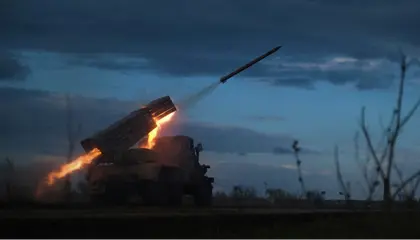Russia’s obsession with fighting for incremental gains, as they have been in the city of Bakhmut, has left its forces “ill-prepared” to respond to Kyiv’s expected counteroffensive, according to Western analysts.
What has the fighting looked like over recent months?
JOIN US ON TELEGRAM
Follow our coverage of the war on the @Kyivpost_official.
In places like Bakhmut over the winter, Ukrainian and Russian forces have been locked in a grinding fight of attrition that has cost both sides huge amounts of casualties for often just yards of land either gained or lost.
The fighting here has been reminiscent of the trench warfare of World War I, characterized by artillery barrages and brutal close quarters fighting, as seen in this incredible head-cam footage shot just a few days ago.
How will fighting in the counteroffensive differ?
In short, massively. Russia’s attacks over the winter have been carried out with small-scale frontal assaults against Ukrainian positions carried out on a relatively local level.
The Institute for the Study of War (ISW) notes in its latest assessment: “These small-scale attacks do not require particularly involved command and control capabilities as local commanders can likely choose particular units or groups of individuals for attacks at times and places of their choosing and then focus their attention on those localized operations.”
Although the exact details are a closely guarded secret, Ukraine’s counteroffensive will be a large-scale mechanized counteroffensive against a wide front.

Kyiv Hit by Massive Drone Attack as Russian Strikes Target Multiple Ukrainian Cities
Russia’s troops and commanders will find themselves having to switch from conducting small and localized maneuvers to coordinating highly complex defense operations across hundreds of miles of land.
The ISW notes: “Attacking Ukrainian forces will determine the times and places at which fighting occurs and will likely press across much wider areas than the attack sectors Russian commanders have typically focused on.”
Surely the Russians are preparing for this?
Even if commanders are now planning detailed measures to blunt Ukraine’s counteroffensive, they still have to rely on their troops to carry out these orders.
Unfortunately for the Kremlin, Russia has already lost a huge chunk of its most experienced troops in the botched first few months of the full-scale invasion.
Instead, Russia will be relying mostly on troops mobilized since Ukraine’s counteroffensives in the Kherson and Kharkiv regions last year, who have no experience of defending against a large and mechanized attack.
The ISW adds: “The experience of combat that most Russian tactical and even operational commanders have is thus unlikely to prepare them well for the challenges they are likely to face.
“They are unlikely to be emotionally or intellectually prepared to respond to such an assault regardless of combat experience they have gained in the offensive operations of which they have hitherto been part.”
So the counteroffensive will be pretty easy for Ukraine?
Far from it. Open-source media and Ukrainian intelligence spokespersons report Russia has built at least two, and in some sectors three, fortification belts in Ukraine’s southern regions.
Pro-Moscow media have widely reported concentrations of regular Russian army reserves, including elite airborne units, in cities backstopping those defensive lines, particularly in Melitopol, Berdyansk and Mariupol.
How does Ukraine intend to break these fortifications?
US Joint Chiefs of Staff secret planning documents recently leaked into gamer-associated social media estimate nine newly formed brigades equipped largely with NATO-standard equipment – on paper a force of between 20,000 and 25,000 soldiers – will be the backbone of Ukraine’s main assault and have the mission of driving south and destroying all in their path, once frontline Russian defenses are broken.
In past offensives, the Armed Forces of Ukraine (AFU) had preceded their armored and mechanized assaults with heavily armed infantry using drones and night vision equipment. As the war has ground on, Kyiv’s infantry has become increasingly skilled at infiltrating past defensive works and clearing fortifications.
AFU commander Gen. Valery Zaluzhny will, some observers have said, likely lead assaults in most sectors using infantry tasked with breaking into Russian fortifications, to be followed by a blitzkrieg-style tank and armored fighting vehicle assault able to drive deep and fast in a breakthrough, when the gap in the fortifications is wide enough.
Analysts interviewed by Kyiv Post were generally optimistic that once the AFU kicked off their ground assaults, even against heavily defended sectors, the combination of NATO training and equipment, along with Ukrainian soldiers’ motivation and morale, would more than likely allow Ukrainian units to break through or even overrun Russian positions, potentially causing Kremlin forces to suffer severe losses in men, equipment and fighting vehicles.
This optimism was also tinged with some caution in predicting how well the AFU could manage the logistic support to a fast-moving offensive. Sergio Miller, a retired British Army intelligence officer, said: “A remarkable capacity to sustain ‘pick-up and minivan resupply’ to defensive enclaves has been demonstrated [by the AFU] for many months. But can this be transformed into conventional resupply of advancing spearheads?”
It will be vital that Ukraine’s military logistics chains – which up to now have been organized to deliver combat supplies to a relatively static fighting line – be able to deliver the supplies needed to maintain fast-advancing combat units. Whether they can is a yet-to-be-answered question. “AFU logisticians have never had to attempt that before,” said Florian Blanaru, a retired Romanian army operations officer.
You can also highlight the text and press Ctrl + Enter






